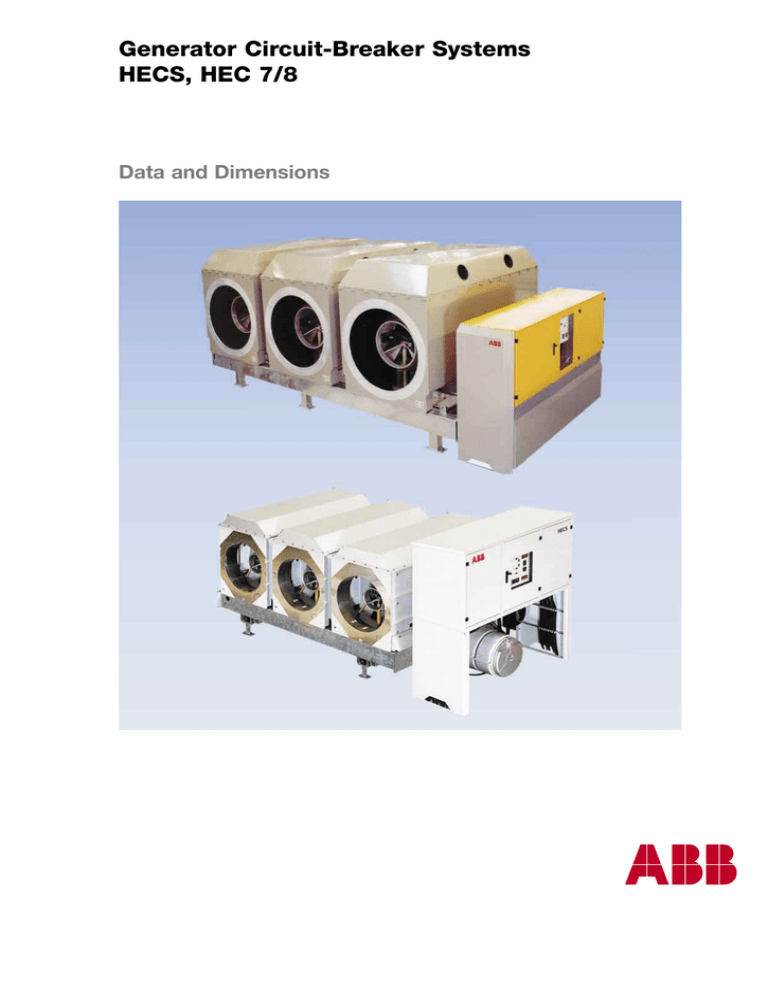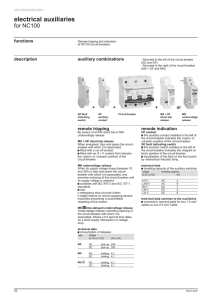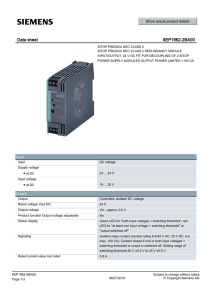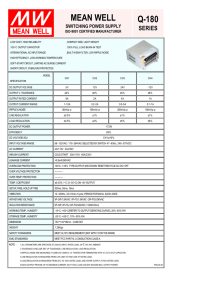ABB Generator Circuit-Breaker Systems HECS, HEC 7/8 Data
advertisement

Generator Circuit-Breaker Systems HECS, HEC 7/8 Data and Dimensions 2 ABB Contents Application Characteristics Standards and quality Modular design concept Equipment options Generator circuit-breaker Disconnector Earthing switch Starting switch Short-circuiting connection Current transformer Voltage transformer 3 3 3 4 5 5 8 9 9 9 10 10 Surge arrester Surge capacitor Terminals Phase enclosure Control and supervision Tests Transport to site Site erection and commissioning Maintenance and overhaul Dimensions Technical data 10 10 11 11 11 12 12 12 12 13 14 Application The Generator Circuit-Breaker System type HECS and HEC 7/8 has been developed as a system suitable for application in all types of power plants. The HECS and HEC 7/8 Generator Circuit-Breaker Systems are also suitable for retrofitting in existing power plants, when these are modernised, extended and/or automated. It is available for both indoor and outdoor application. Characteristics • 3-phase system with a SF6 circuit-breaker and disconnector in series with the circuit-breaker, in single-phase enclosures, supplied fully assembled on a common frame, with operating mechanisms, supervisory and control equipment. • Additional components as earthing switches, starting switch (for starting of gas-turbines), current- and voltage transformers, surge capacitors, surge arrester, all integrated and mounted in the phase enclosures, can be provided. Additionally the earthing switch on the breaker side of the HECS Generator CircuitBreaker System (if equipped with an optional short- circuiting bar) can be used as a short-circuiting link during power plant protection setting, whereas the HEC 7/8 for this purpose can be equipped with a short circuiting connection which is either manually mounted or motor operated. • The phase distance can be selected to suit the busbar spacing in the power plant. Standards and quality The Generator Circuit-Breaker System type HECS and HEC 7/8 fulfil the requirements of all relevant standards, i.e. IEEE (ANSI) Std C37.013 and IEC 60694, IEC 62271-102, IEC 60044-1/2, IEC 60099-4, IEC 60358, IEC 60529, IEC 61166. ABB ABB High Voltage Products is continuously endeavoured to improve its quality-assurance-system; this has been recently new assessed by The Swiss Association for Quality and Management Systems with the SQScertificate ISO 9001 / ISO 14001. 3 Modular design concept The standard design includes: • SF6 circuit-breaker and disconnector • Earthing switches on one or both sides (for HECS: on breaker side also optional available with shortcircuit bar to be used as short-circuiting link) • Current transformers on one or both sides with up to three cores per current transformer (depending on the class) As required by the plant layout, individual components can be deleted from the standard execution. The standard execution can be extended by the following optional items: • For HECS: Short-circuiting connection - either in connection with generator side earthing switch, or to be manually mounted (for power plant protection setting) • Voltage transformers on one or both sides with one or two secondary windings • For HEC 7/8: Short-circuiting connection - either permanently fitted with switch, or to be manually mounted (for power plant protection setting) • Starting switch for (reduced voltage) starting the gas turboset via SFC (Static Frequency Converter) • Surge arrester on transformer side. • Surge capacitors on both sides. View into one pole of circuit-breaker type HECS-130L 4 ABB Equipment options 1 Generator circuit-breaker 6 Surge capacitor 2 Line disconnect switch 7 Current transformers 3 Earthing switch 8 Voltage transformers 4 Starting switch for SFC connection 9 Surge arrester 5 Manual short-circuiting connection (by removal of cover) 10 Motor-operated short circuiting link (only HECS with generator side earthing switch) Generator circuit-breaker Interrupting chamber Within the interrupting chamber SF6-gas is used for both arc extinguishing and internal insulation. The external insulation is air. For the interruption a combination of the self-extinguishing and the puffer principle is used, a design optimised to achieve a significant reduction in operating energy. This self-pressurising principle allows high breaking capacities as well as almost overvoltage-free interruption of small (inductive) currents. Separate contact systems for breaking and for continuous current carrying are used. This avoids wear / erosion of the continuous current contacts and ensures trouble-free current carrying even after a large number of operations. ABB Interrupting chamber of the circuit-breaker type HECS-100L. On the left the terminal is visible. The circuit-breaker contacts are operated by a shaft passing from below, through the vertical support insulator. 5 Mode of operation of the interrupting chamber of the HECS circuit-breaker systems 7 a Circuit-breaker “CLOSED” b Initiation of opening movement, (transfer of current from the main contacts to the arcing contacts) 2 3 4 a 9 6 c Separation of arcing contacts with interruption of small currents supported by puffer action b 5 2 d Separation of arcing contacts with interruption of large currents – supported by the thermal effect of the current arc itself to build up the pressure in the heating volume 3 e Circuit-breaker “OPEN” 1 c d 7 6 5 4 9 8 e 1 Terminals 6 Moving main contact 2 Cylindrical coil 7 Puffer 3 Fixed arcing contact 8 Heating volume 4 Moving arcing contact 9 Gas compartment 5 Fixed main contacts Hydraulic spring drive The hydraulic spring operating mechanism combines the advantages of a hydraulic operating mechanism with those of a spring energy storage system. Energy storage is accomplished with the aid of a disk spring assembly, with the advantages of high long-term stability, reliability and non-influence of temperature changes. Tripping of the operating mechanism and energy output are based on proven design elements of the hydraulic operating technique, such as control valves and hydraulic cylinders. 1 1 O I M M 2 High pressure Low pressure 2 1 Breaker operating rod 2 Energy storage device Schematic diagram of the hydraulic spring operating mechanism 6 The operating mechanism is based on the so-called differential piston principle (between the larger piston head side area and the smaller piston rod side area). For the closing operation the piston head side is isolated from the low pressure and simultaneously connected to the high pressure oil volume. As long as the pressure is maintained, the piston remains in the “CLOSED” position. A pressure controlled mechanical interlock prevents movement of the piston to the “OPEN” position in case of a pressure drop. View of the hydraulic spring operating mechanism ABB For the opening operation, the piston head side is isolated from the high pressure and simultaneously connected to the low pressure oil volume. The charging state of the spring disk assembly is controlled by switching elements, actuating the pump motor to immediately maintain the oil pressure. For emergency use or maintenance, charging of the spring disk assembly and tripping is possible locally. The fully integrated construction has no hydraulic pipe connections of any kind. A non-return valve between pump and high-pressure oil volume prevents pressure loss in the event of a pump outage. The hydraulic system is hermetically sealed against atmosphere (no corrosion). The mechanically operated position indicator provides reliable indication of the circuit-breaker position. The drive operates all three breaker poles simultaneously by mechanical linkages, thus keeping the switching time difference between the poles to a minimum. SF6-gas density monitoring system The breaking capacity of an SF6 circuit-breaker and the dielectric withstand level across its open contacts is dependent upon the density of the SF6-gas. Under the condition of constant volume the gas density is independent of the gas temperature, while the pressure varies with the temperature. It is therefore more practical to measure and use the gas density rather than the pressure for circuit-breaker supervisory purposes. The functional principle of the density monitor is shown in below diagram. The density monitor operates according to the reference-volume-density principle. The density of the gas in the circuit-breaker chamber is compared with the density of the gas in a sealed reference gas volume. When the gas density drops below the specified value, the density monitor signals the loss of SF6-gas in several steps. It is mounted on the crankcase of the middle pole. Since the gas volumes of the three breaker poles are connected via the refilling pipe only one SF6-gas density monitor per breaker is required to supervise the gas density. 6 5 SF6-gas density indication and filling connection 3 900 850 900 p [kPa] 750 700 650 600 550 500 450 p [kPa] 850 800 4 800 750 3 700 2 650 1 600 550 Schematic diagram of the SF6-gas density monitor 500 1 Pressure connection 2 SF6-gas volume of the circuit-breaker 3 Metallic bellows 450 400 -40 -30 -20 -10 400 -40 -30 -20 -10 0 0 10 20 30 10 20 30 40 50 60 70 t [°C] 40 50 60 70 80 90 100 4 Reference gas volume 5 Actuating rod 6 Microswitch 80 90 100 P/t-diagram for SF6-gas, with operating characteristics of the gas [°C] density monitor for the SF6 tcircuit-breaker Rated filling density 40.7 kg/m3 Alarm density 36.1 kg/m3 Blocking density 34.7 kg/m3 ABB 7 Disconnector The switchgear concept provides a disconnector fitted in series with the circuit-breaker. It is placed on the out-going side of circuit-breaker and within the same enclosure. The disconnector is a tubular telescopic unit, with the moving contact on the terminal side and fixed contact tube on the circuit-breaker side. This layout provides easy access and simplifies maintenance. In the open position of the disconnector the isolating air distance can be clearly seen through an inspection window in the side wall (HECS) or in the cover (HEC 7/8) of the enclosure. The moving contact is motor driven. View through the inspection window of HECS to assure that the disconnect switch is in the open position. The operating mechanism is a compact subassembly, including the motor, auxilary switch, reduction gear box and coupling flanges in one unit. Key locking in the positions “CLOSE” and “OPEN” is a standard facility. An additional locking prevents motor operation while the disconnector is being manually operated. Mechanically driven position indicator is provided in a readily visible position and a crank handle is provided for manual operation. The operating mechanisms, as for disconnector, earthing switch, starting switch are shown, the operating mechanisms for disconnector and all switches are identical and integrated in the pole frame. They incorporate a driving motor and gearing, a mechanical semaphore, key locking and an electrical auxilary switch. The sticker shows the different operation modes of the key locking scheme of the individual motor operating mechanisms, which all of them operate in the same way. 8 ABB Earthing switch The earthing switch can be provided on either one or both sides of the system. The switch and its connections are designed for protective earthing purposes, i.e. it is rated for the full fault current but has no current making or continuous carrying capacity. Design is of a blade type with the hinge point connected to the enclosure and the fixed contact to the current path. The earthing connection is made via the system enclosure, which is earthed at one end to the busbar enclosure. The moving contact is motor driven. Starting switch The starting switch can be provided on the generator side of the system. The starting switch and its connections have been designed for the voltage, current and current-duration occurring during the SFC (Static Frequency Converter) startup period of the gas turboset. The design is of a blade type with the fixed contacts at the current path and the hinge point isolated from the enclosure. High voltage cables can be connected to this. The moving contact is motor driven. Breaker type HECS Earthing switch in closed position. Short-circuiting connection For the HEC 7/8 there is either a manual short circuiting connection or an electrical operated short-circuiting switch available. The manual short-circuiting connection can be provided for the use between the circuit-breaker and the disconnector of the system. This arrangement has been designed for installations where the short-circuiting facility is only rarely used. The short-circuiting connection is built for the voltage, current and current duration occurring during the testing and adjustment of the power plant protection system. The cover of each of the phase enclosures has to be removed to allow the fitting of the short-circuiting busbar. from the enclosure (2000 V), and is protected against inadvertently touching. The moving contact is motor driven. As an additional feature, a link can be provided with which the short-circuit connection can be connected to the phase enclosure i.e., to earth. This link can only be fitted manually. The short-circuiting switch can be provided between the circuit-breaker and the disconnector of the system. The short-circuiting switch and its connection between phases have been developed to expedite the testing and adjustment of the power plant protection system. Closure of the switch establishes an unearthed three phase short-circuit, which then can be switched to the generator terminals by closure of the circuit-breaker. The design of the switch is of a sliding type with the moving contact isolated from the enclosure and the fixed contact connected to the current path. The actual short-circuiting connection between the phases is established external to the enclosure and being insulated Alternatively there is a motor operated short-circuiting connection available for the HECS. If a motor operated short-circuit connection is required, the three poles of the earthing switch on the breaker side are linked together to a common bar, which is connected by a copper bracket to the enclosure of the middle phase and thereby grounded. By removing this bracket (to be done manually) and closing of the earthing switch an unearthed three phase short-circuit is established. The closing of the earthing switch can be done motor operated (local/remote switch in position local) while the generator is de-excited and the residual voltage of the generator does not exceed 350 V. ABB For the HECS there is also a manual short circuiting connection available which needs to be connected between the circuit breaker and the disconnector. The cover of each of the phase enclosures has to be removed to allow the fitting of the short-circuiting busbar. 9 Current transformer A ring core current transformer can be provided on either one or both sides of the breaker system. Depending on the class up to three cores per current transformer can be accommodated, depending on output and class required. The secondary windings are permanently wired back to terminal blocks in the control cubicle. Voltage transformer Ring core current transformers with up to 3 cores per transformer can be mounted at each end of each phase enclosure. Single-phase, cast resin voltage transformers can be provided on either one or both sides of the breaker system. Up to three voltage transformers or two voltage transformers and one surge arrester can be fitted at each side and each voltage transformer can be supplied with one or two secondary windings, depending on the class and output power required. The secondary windings are permanently wired back to terminal blocks in the control cubicle. Surge arrester A surge arrester can be fitted on the transformer side, to provide protection for transformer and generator against overvoltages. Standard is an ABB metal-oxide surge arrester of the POLIM range with silicon housing. Metal-oxide resistors have a highly non-linear resistance characteristic. At service voltage a predominantly capacitive current of < 1mA flows. Any voltage increase leads to a rapid increase of the current, thereby limiting any further rise in the voltage. When the voltage decreases, the condition reverts to its essential non-conducting state. Metal-oxide surge arresters are characterised by the residual voltage, i.e. the voltage during the passage of an impulse current. The voltage transformers are fitted on the side panel of the phase enclosure. The surge arrester is fitted on the side panel of the phase enclosure. Surge capacitor Surge capacitors are fitted on both sides of the breaker system, to provide additional protection against overvoltages and to support arc extinction in the circuitbreaker by TRV limitation. The surge capacitors are fitted outside the phase enclosure with only the porcelain bushings protruding into the phase enclosure. Surge capacitor are installed in such a manner that only their porcelain bushings protrude into the phase enclosure. 10 ABB Terminals The current path of the system is connected to the busbar current path by bolted flexible, laminated or stranded connectors. In order to avoid detrimental tensile stresses to the terminals, resulting from electro-dynamic forces of a short-circuit current, the flexible connectors must be supported at the midpoint by a ring having the same diameter as the terminals. These rings reduce the con- traction of the flexible connectors and the subsequent tensile forces on switchgear components, under shortcircuit current conditions. Note: The flexible connectors are not part of the scope of supply of the GCB system, usually they are supplied by the IPB supplier. Phase enclosure The phase enclosures are designed to carry the induced reverse current, flowing through the isolated phase busbar enclosures. Thus the external magnetic field and its influence to the equipment is minimised. As standard, the phase enclosure is welded onto the busbar enclosure, ensuring continuity of the phase enclosure characteristics. On the other hand, the phase enclosures effectively eliminate any possibilty of accidental contact with live components. In order to avoid pollution due to ingress of dust and/or moisture, the phase enclosures are made airtight to withstand also a small internal overpressure. Windows are provided in the phase enclosures near to the disconnector, earthing switches and starting switch, to allow visually checking of the position of each of them. Control and supervision Phase enclosures and control cubicle of GCB system type HECS-130L Phase enclosures and control cubicle of GCB system type HEC 7/8 All control and supervisory apparatuses are mounted in the control cubicle. The control cubicle is placed on the operating mechanism side of the system above the operating mechanism of the circuit-breaker and is not mechanically connected with the common frame of the breaker system. An active mimic diagram is provided with the actual position indications and the integrated local control of the circuit-breaker and all other switching apparatuses. It is mounted in the door panel behind the glass door of the control cubicle. In the control cubicle there are also installed a local/ remote change-over switch and counters for C-O operations of the circuit-breaker and pump startings of the circuit-breaker drive. Mimic board of the control cubicle ABB 11 Tests Type tests Routine tests The performance of the generator circuit-breaker system was fully tested by the High Power Laboratory of KEMA/Netherlands in accordance to the standard IEEE C37.013 with regard to the interrupting capability. After production, but prior to dispatch, the system is subject to an extensive test program, as: Further type tests were carried out with all of the related components within the system to prove continuous current capability, dielectric strength, long term endurance, noise level etc. and verify the liability and compliance with the requirements of the relevant IEC-standards. • Design and visual checks • Dielectric tests on the main circuit • Dielectric tests on auxiliary and control circuits • Measurements of the resistance of the main circuit • Mechanical operation tests • Timing tests and recording the switching times and movement of breaker contacts • Functional tests of individual components • Leakage test of phase enclosures • SF6-gas leakage test. Transport to site The entire system is fully assembled and tested together with all its ancillary equipment in the factory. It is hence dispatched from the factory and transported to site as a single unit. Note: Exception - control cubicle according to ANSI standard. Site erection and commissioning Site erection requires a well prepared foundation. Due to the fact, that the system is delivered as a single, fully assembled, wired and tested unit, the time, required for erection, testing and commissioning is extremely short. The only substantial site work is the welding of the enclosures onto the busbar enclosures, the mounting of the flexible high-current connections, the connecting of the electrical supply cables and the performing of the commissioning tests. Maintenance and overhaul The HECS and HEC 7/8 generator circuit-breaker systems are maintenance-free to a wide extend. Overhaul can be scheduled based on service time, number of C/O-operations or number of current interruptions. Removal of the phase enclosure top covers provides easy access to the active components of each phase, including the instrument transformers, surge capacitors and surge arrester. 12 The contact erosion can be measured without opening the interrupting chamber with the DRM-methode (Dynamic Resistance Measurement), which has been specifically developed for generator circuit-breakers by ABB High Voltage Products. This allows to optimise the service intervals also for frequent switching of higher service currents. The DRM-Measurement system can be ordered separately. ABB Dimensions Type HECS Type HEC 7/8 ABB 13 Technical data Generator circuit-breaker system type General: Rated maximum voltage Rated frequency HECS-80 HECS-100 HECS-130 kV Hz 23 50/60 25.3 50/60 25.3 50/60 10500 13000 18000 13000 18000 10000 12000 17000 12000 17000 Rated continuous current 50 Hz Rated continuous current 50 Hz Rated continuous current 50 Hz Rated continuous current 50 Hz S M L XL* A rms A rms A rms A rms 8500 10500 Rated continuous current 60 Hz Rated continuous current 60 Hz Rated continuous current 60 Hz Rated continuous current 60 Hz S M L XL* A rms A rms A rms A rms 8000 10000 Rated insulation level: Rated power frequency withstand voltage to earth and across circuit-breaker/switch contacts across isolating distance of disconnector Rated lightning impulse withstand voltage to earth and across circuit-breaker/switch contacts *) across isolating distance of disconnector Circuit-breaker: Rated peak withstand current Rated short-time withstand current Rated short-circuit making current Rated short-circuit breaking current Rated operating sequence Rated interrupting time kV rms kV rms 60 70 60 70 60 70 kV peak kV peak 125 145 125 145 125 145 kA peak kA, 3 s kA peak kA rms 220 80 220 80 360 130 360 130 67 280 100 280 100 CO-30min-CO 67 ms 67 Disconnector: Rated peak withstand current Rated short-time withstand current Operating time kA peak kA, 3 s s 220 80 2 280 100 2 360 130 2 Earthing Switch: Rated peak withstand current Rated short-time withstand current Operating time kA peak kA, 1 s s 220 80 2 280 100 2 360 130 2 The above data are not limiting values. Additional data on request. We reserve the right to alter data and technical details without notice. 14 ABB Generator circuit-breaker system type General: Rated maximum voltage Rated frequency Rated continuous current Rated insulation level: Rated power frequency withstand voltage to earth and across circuit-breaker/switch contacts across isolating distance of disconnector Rated lightning impulse withstand voltage to earth and across circuit-breaker/switch contacts across isolating distance of disconnector Circuit-breaker: Rated peak withstand current Rated short-time withstand current Rated short-circuit making current Rated short-circuit breaking current Rated operating sequence Rated interrupting time HEC 7 HEC 8 kV rms Hz kA 30 50/60 24/22 30 50/60 28/26 kV rms kV rms 80 88 80 88 kV peak kV peak 150 165 150 165 kA peak kA, 1 s kA peak kA rms ms 600 600 220 220 440 440 160*) 160*) CO-30min-CO 56 56 Disconnector: Rated peak withstand current Rated short-time withstand current Operating time kA peak kA, 1 s s 600 220 2 600 220 2 Earthing Switch: Rated peak withstand current Rated short-time withstand current Operating time kA peak kA, 1 s s 440 160 2 440 160 2 *) higher ratings on request The above data are not limiting values. Additional data on request. We reserve the right to alter data and technical details without notice. ABB 15 ABB Switzerland Ltd High Voltage Products Brown Boveri Strasse 5 CH-8050 Zurich / Switzerland Phone: +41 58 58 83424 Fax: +41 58 58 81644 www.abb.com 1HC0023255 E01 / AC05



